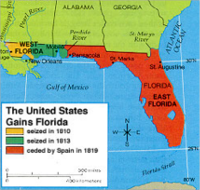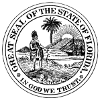The Making of the 50 States: Florida
Part 2: The Rest of the Story 
American settlers moved into Florida in increasing numbers as the 19th Century began. A number of Creek Indians had moved into the area in the late 1760s and become the Seminoles. Native Americans, primarily the Seminoles, didn't appreciate it all that much and acted to keep American settlers out. Florida was increasingly a haven for runaway slaves. The neighboring states–Georgia and South Carolina–had large plantations and farms that required slave labor, and their state governments allowed slavery. Florida wasn't a state at this time and also had no laws governing slavery. The U.S. Army responded with an invasion, in 1817, led by General Andrew Jackson. Jackson led his troops to victory, and the U.S. took control of part of the Florida territory. Through a series of annexations and sheer force of numbers, the U.S. eventually took control of both Floridas. They became the joint Florida Territory in 1822; Andrew Jackson was the first territorial governor. The capital was Tallahassee. A number of tribes signed the 1832 Treaty of Payne's Landing, agreeing to leave Florida voluntarily in exchange for land west of the Mississippi River. Some tribes stayed, however, and another war against the Seminoles began in 1835 and lasted, off and on, for seven years. 
Florida residents decided to allow slavery within their borders. When Florida petitioned to become a state, in 1845, Congress expressed the same reluctance as when Missouri was seeking entrance to the Union. With Florida, as with Missouri, the solution was the admittance of a Northern state, in this case Iowa. Florida became the 27th state on March 3, 1845. First page > In the Beginning > Page 1, 2
|
|
Social Studies for Kids
copyright 2002–2024
David White




